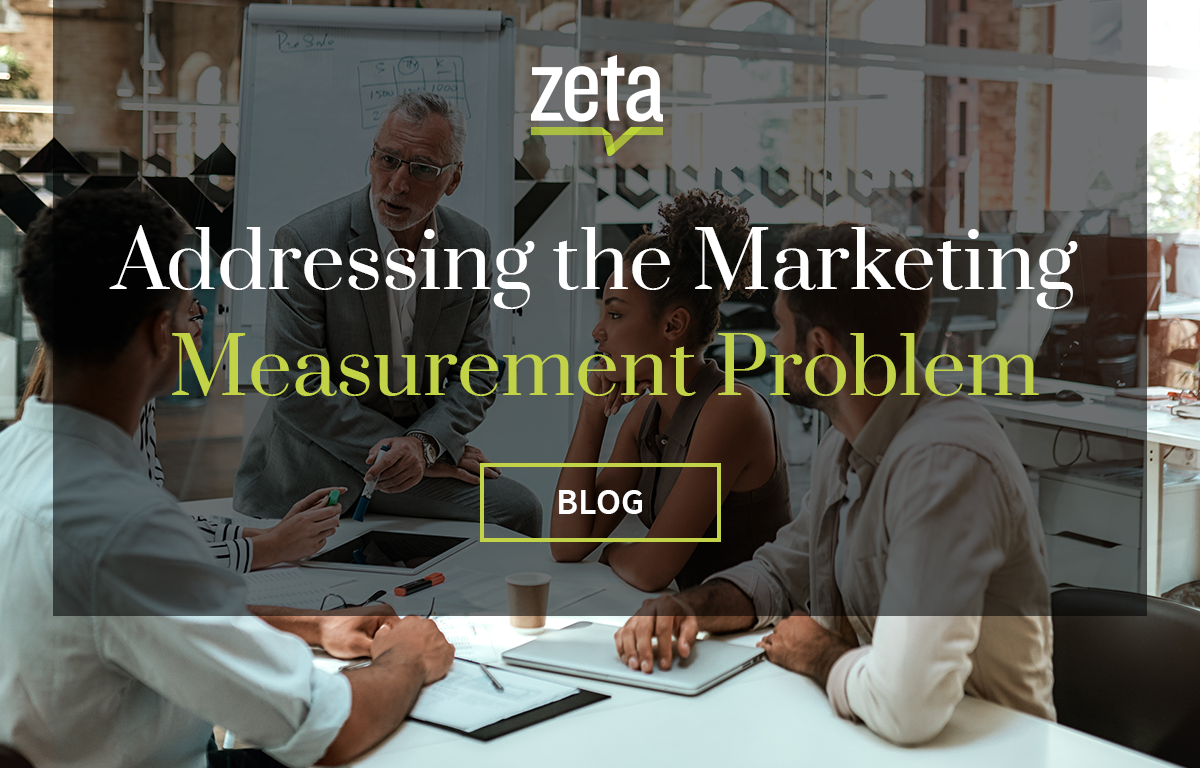
Articles | March 22, 2021 | 3 min read
Addressing the Marketing Measurement Problem
Marketers are sitting between a rock and hard place. Traditional performance metrics like clicks and impressions are losing their luster, but higher-value metrics like revenue and net-profit are difficult to obtain. This is the essence of the marketing measurement problem.
As a result, getting budgets approved is becoming more difficult by the day. CFOs want evidence that marketing spend will create value for the company before making a financial commitment.
That means the onus is on you—the marketer—to draw a straight line between your campaigns and the cash coming into company coffers.
Imagine spending $1000 on a Facebook ad that will be shown to 5,000 people.
In the week following the launch of the ad, your company records 10 sales derived from Facebook, each worth $500 (for a total of $5,000 in revenue).
Using a traditional evaluation metric like return-on-ad-spend (ROAS), you might tell your CFO that the ad campaign was a screaming success. After all, you spent $1,000 and generated $5,000—a 5:1 ROAS.
But this is where a classic marketing metric like ROAS misses the mark because it’s not telling the full story.
But should you get all the credit? What if 9 of the 10 sales credited to your campaign would have happened no matter what? What if those 9 customers were planning to buy your product anyway, long before they were ever exposed to your ad?
Examined through that lens, you spent $1,000 to generate a single, net-new sale worth $500. That’s a -$500 return-on-ad-spend.
Is that a result you’d be excited to share with your CFO?—Probably not.
Incrementality measurement is how you go about obtaining the true results of any marketing initiative you run (like the hypothetical campaign referenced in the preceding section). Using incrementality measurement, a marketer can determine the exact influence (i.e., the incremental benefit) in achieving their desired business outcome (e.g., more revenue). It measures the true lift of your campaign against your stated goals.
Put another way, incrementality matters because it replaces inferior forms of measurement such as media mix modeling, attribution measurement, and panel-based measurement.
(If you need a refresher on incrementality measurement, read this blog: What Is Incrementality Measurement and How Does it Work?)
Most marketers eat hidden costs when it comes to incremental measurement. Most of these costs are related to the use of control groups.
As just one example, imagine you have a group of 100 ideal prospects.
However, for the sake of incrementally evaluating your campaign, you withhold 10 of those prospects as a control group.
That’s 10 ideal engagements that you’re sacrificing for the sake of your test. In this scenario, you’re eating a 10% opportunity cost because only 90% of your ideal prospects will see your marketing (rather than 100%).
Put another way, you’re losing $0.10 on every potential dollar just to measure the true effectiveness of your campaign—that’s a steep price to pay for an experiment.
The good news is, these and other costs can be entirely avoided through the use of always-on incrementality.
Every marketer wants to use their limited resources in the most effective, ROI-generating way possible—that’s why they try to use incrementality measurement in the first place.
But even within the world of incrementality, there’s a right way and a wrong way to get the job done. The right way will help you make the most of your money and ensure you’re not paying expensive opportunity costs just to measure the performance of your campaigns. The wrong way will see you, your campaigns, and your brand get burned in the long run.
Always-on incrementality—an ever-evolving feedback loop that optimizes client campaigns based on real-time inputs derived from regular incrementality measurement—is the right way.
To learn more about always-on incrementality, and how you can bring it to your organization, please ready our whitepaper: The Costly Mistake Marketers Make With Incrementality Measurement.
As a result, getting budgets approved is becoming more difficult by the day. CFOs want evidence that marketing spend will create value for the company before making a financial commitment.
That means the onus is on you—the marketer—to draw a straight line between your campaigns and the cash coming into company coffers.
Traditional marketing measurement doesn’t paint a clear picture
Imagine spending $1000 on a Facebook ad that will be shown to 5,000 people.
In the week following the launch of the ad, your company records 10 sales derived from Facebook, each worth $500 (for a total of $5,000 in revenue).
Using a traditional evaluation metric like return-on-ad-spend (ROAS), you might tell your CFO that the ad campaign was a screaming success. After all, you spent $1,000 and generated $5,000—a 5:1 ROAS.
But this is where a classic marketing metric like ROAS misses the mark because it’s not telling the full story.
ROAS assigns you and your ad 100% of the credit for each of the 10 sales.
But should you get all the credit? What if 9 of the 10 sales credited to your campaign would have happened no matter what? What if those 9 customers were planning to buy your product anyway, long before they were ever exposed to your ad?
Examined through that lens, you spent $1,000 to generate a single, net-new sale worth $500. That’s a -$500 return-on-ad-spend.
Is that a result you’d be excited to share with your CFO?—Probably not.
Incrementality addresses the marketing measurement problem
Incrementality measurement is how you go about obtaining the true results of any marketing initiative you run (like the hypothetical campaign referenced in the preceding section). Using incrementality measurement, a marketer can determine the exact influence (i.e., the incremental benefit) in achieving their desired business outcome (e.g., more revenue). It measures the true lift of your campaign against your stated goals.
Put another way, incrementality matters because it replaces inferior forms of measurement such as media mix modeling, attribution measurement, and panel-based measurement.
(If you need a refresher on incrementality measurement, read this blog: What Is Incrementality Measurement and How Does it Work?)
Incrementality is difficult to do well
Most marketers eat hidden costs when it comes to incremental measurement. Most of these costs are related to the use of control groups.
As just one example, imagine you have a group of 100 ideal prospects.
However, for the sake of incrementally evaluating your campaign, you withhold 10 of those prospects as a control group.
That’s 10 ideal engagements that you’re sacrificing for the sake of your test. In this scenario, you’re eating a 10% opportunity cost because only 90% of your ideal prospects will see your marketing (rather than 100%).
Put another way, you’re losing $0.10 on every potential dollar just to measure the true effectiveness of your campaign—that’s a steep price to pay for an experiment.
The good news is, these and other costs can be entirely avoided through the use of always-on incrementality.
Always-on incrementality
Every marketer wants to use their limited resources in the most effective, ROI-generating way possible—that’s why they try to use incrementality measurement in the first place.
But even within the world of incrementality, there’s a right way and a wrong way to get the job done. The right way will help you make the most of your money and ensure you’re not paying expensive opportunity costs just to measure the performance of your campaigns. The wrong way will see you, your campaigns, and your brand get burned in the long run.
Always-on incrementality—an ever-evolving feedback loop that optimizes client campaigns based on real-time inputs derived from regular incrementality measurement—is the right way.
To learn more about always-on incrementality, and how you can bring it to your organization, please ready our whitepaper: The Costly Mistake Marketers Make With Incrementality Measurement.


